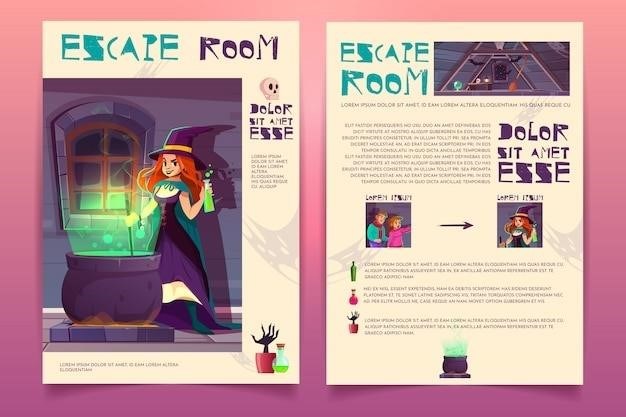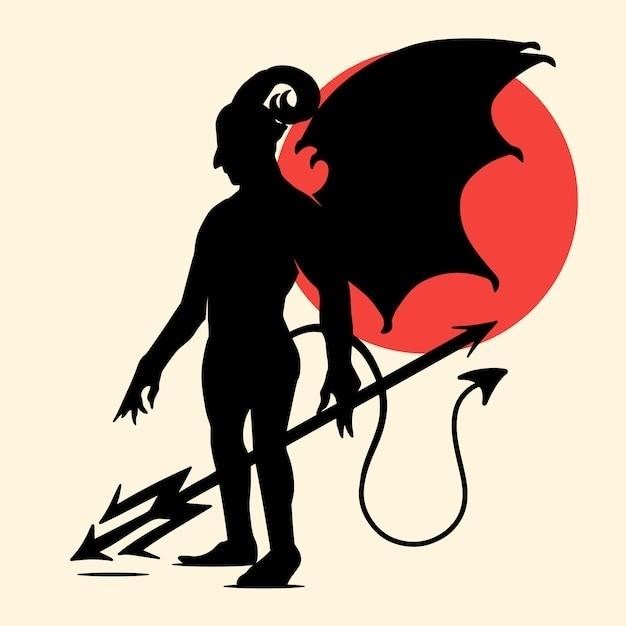

Dictionary of Demons PDF⁚ A Comprehensive Overview
Digital and physical copies of demon dictionaries offer extensive resources for researching demonology. These compilations detail demonic entities, hierarchies, and lore. Expanded editions frequently include additional entries, illustrations, and scholarly articles. Access is available online and through libraries or specialized bookstores, facilitating comparative analysis across various sources.
The Most Popular Dictionaries of Demons
Several dictionaries of demons stand out for their comprehensiveness and influence within the field of demonology. M. Belanger’s “The Dictionary of Demons,” particularly its expanded editions, is frequently cited for its detailed entries and insightful analysis of demonic entities. Its popularity stems from the author’s extensive research and incorporation of various historical and cultural perspectives on demons. Another widely recognized work is Jacques Collin de Plancy’s “Dictionnaire Infernal,” known for its historical significance and detailed descriptions, organized in hierarchical structures reflective of traditional demonological systems. These dictionaries, often available in PDF format, provide researchers and enthusiasts with valuable resources for studying demons and their associated lore. The accessibility of these PDFs allows for widespread study and comparison of different demonological perspectives.
M. Belanger’s “The Dictionary of Demons”⁚ Expanded Editions and Content
M. Belanger’s “The Dictionary of Demons” has undergone several expansions since its initial publication, significantly increasing its scope and depth. These expanded editions showcase Belanger’s ongoing research into demonology, incorporating newly discovered information and reinterpretations of existing knowledge. The additions often include hundreds of new entries detailing previously undocumented demons, expanding upon existing entries with more detailed descriptions, and incorporating new illustrations and artwork. The expanded editions also frequently feature supplemental articles and appendices that delve into specific aspects of demonology, such as historical context, cultural interpretations, and the symbolic significance of various demonic attributes. These additions have solidified the book’s position as a leading resource in the field.
Jacques Collin de Plancy’s “Dictionnaire Infernal”⁚ Editions and Significance
Jacques Collin de Plancy’s “Dictionnaire Infernal,” initially published in 1818, stands as a seminal work in demonology. Its enduring influence stems from its detailed descriptions of demons, organized within hierarchical structures reflecting the beliefs of the time. Multiple editions followed the original publication, each potentially containing revisions, additions, or alterations to the original content. The 1863 edition is frequently cited as a particularly notable version. The “Dictionnaire Infernal” is significant not only for its comprehensive catalog of demons but also for its historical context, reflecting prevalent beliefs and anxieties surrounding the supernatural in 19th-century Europe. Its illustrations, often quite striking, further contribute to its lasting impact and continued study by researchers and enthusiasts alike; The book’s accessibility through various editions and formats, including potentially digital versions, ensures its continued relevance.
Exploring Different Demon Dictionaries
Numerous demon dictionaries exist, each offering unique perspectives and content. These resources vary in scope, depth, and approach to demonology, providing diverse interpretations of demonic entities and their lore.
Kimberly Daniels’ Works on Demonology and Spiritual Warfare
Kimberly Daniels, a prominent figure in spiritual warfare teachings, offers valuable insights into demonology. Her work often goes beyond simple lexicographical listings, delving into the practical application of understanding demonic forces. This approach focuses on spiritual combat and strategies for believers engaging with malevolent entities. While not strictly dictionaries in the traditional sense, her books provide extensive information on demons, their activities, and how to counter their influence. Daniels’ contributions emphasize the spiritual context of demonology, offering a perspective that integrates theological understanding with practical guidance for spiritual warfare. Her writings are a rich resource for those seeking to understand and engage with the subject from a faith-based perspective, supplementing purely academic approaches to demonology. They provide a practical framework for readers interested in spiritual self-defense and understanding the spiritual realm.
Other Notable Demon Dictionaries and Their Contents
Beyond the well-known works, numerous other demon dictionaries exist, each offering a unique perspective on the subject. Some focus on specific traditions or cultures, detailing demons relevant to those belief systems. Others might prioritize historical context, tracing the evolution of demonological beliefs across different eras. The contents vary widely; some are encyclopedic in scope, providing detailed descriptions of numerous entities, while others adopt a more thematic approach, exploring specific aspects of demonology such as demonic hierarchies or rituals. Many incorporate illustrations, artwork, or symbolic representations alongside textual descriptions, enriching the reader’s understanding. The selection of demons included, the depth of descriptions, and the overall approach taken all contribute to the uniqueness of each dictionary. These variations reflect the multifaceted nature of demonology itself, offering diverse interpretations and perspectives on the subject matter. Researchers should consider the specific focus and methodology of any given dictionary before using it as a reference.
Accessing and Utilizing Demon Dictionaries
Demon dictionaries are accessible through various avenues⁚ online databases, libraries, and specialized bookstores. Careful comparison of different sources ensures a comprehensive understanding of demonological information.
Online Resources and Digital Versions of Demon Dictionaries
The digital age has revolutionized access to demonological information. Numerous websites and online archives offer digitized versions of classic demon dictionaries, such as Collin de Plancy’s “Dictionnaire Infernal” and Belanger’s “The Dictionary of Demons.” These online resources often provide searchable text, allowing for quick reference and in-depth study. Furthermore, many online bookstores sell digital versions of demonological texts in PDF or ePub formats, convenient for researchers and enthusiasts alike. The convenience of online access allows for easy comparison of various sources and facilitates a more comprehensive understanding of the subject matter. Researchers can readily cross-reference information, identify discrepancies, and build a more nuanced perspective on the historical and cultural contexts of demonology. The ability to download and annotate digital copies further enhances the research process, creating personalized study materials. However, it is crucial to verify the authenticity and reliability of online sources before using the information for scholarly work, as accuracy varies greatly depending on the source.
Finding Physical Copies of Demon Dictionaries
Locating physical copies of demon dictionaries requires a multifaceted approach. Larger libraries, particularly those with extensive occult or religious studies collections, often hold printed editions of well-known works like Collin de Plancy’s “Dictionnaire Infernal.” Specialized bookstores dealing in rare or antiquarian books may also possess older or less common demonological texts. Online marketplaces such as eBay or Abebooks can be valuable resources, though careful examination of listings and seller reputations is crucial to avoid fraudulent or damaged items. Used bookstores, both online and brick-and-mortar, occasionally offer these titles at more affordable prices. When searching, remember variations in title and author names might be necessary to uncover relevant results. Additionally, consulting online catalogs of major libraries can pinpoint locations holding specific titles, aiding in borrowing or interlibrary loan requests. Patience and persistence are key in this pursuit, as many of these books are not widely stocked and can require considerable searching.
Reviewing and Comparing Different Dictionaries of Demons
Critically evaluating various demon dictionaries necessitates a comparative approach. Consider the publication date, as demonological understanding has evolved over time. Older texts may reflect outdated or culturally specific beliefs. Examine the scope and depth of entries – some focus on specific traditions while others offer broader coverage. The inclusion of illustrations, historical context, and scholarly citations enhances a dictionary’s value. Compare the organizational structure⁚ alphabetical listings versus thematic categorizations influence usability. Cross-referencing information across multiple sources helps identify consistencies and discrepancies. Assessing the author’s expertise and biases is important, as interpretations can vary. Online reviews and scholarly articles can provide valuable insights into a dictionary’s strengths and weaknesses. Ultimately, the “best” dictionary depends on individual research needs and preferred approaches to demonology. A holistic review considering these factors ensures informed selection and utilization.

Understanding Demonology
Demonology, the study of demons, explores their nature, origins, and influence across various cultures and historical periods. It intersects with theology, mythology, and folklore, offering diverse perspectives on these supernatural beings.
Key Concepts and Terminology in Demonology
Understanding demonology requires familiarity with key terms and concepts. “Demon” itself denotes a malevolent supernatural entity, often associated with evil or temptation. Different traditions employ varying classifications, such as succubi and incubi (demons associated with sexual encounters), or specific demonic hierarchies as depicted in some grimoires. The concept of possession, where a demon takes control of a human or animal, is central. Exorcism, the ritualistic expulsion of demons, is a related practice often described in religious texts and folklore. Furthermore, “demonolatry,” the worship of demons, represents a distinct practice within the broader field of demonology, contrasting with the more common negative connotations associated with demons. Understanding these core terms and their varied applications across different cultural and historical contexts is crucial for navigating the complexities of demonological literature and research.
Historical and Cultural Contexts of Demonology
Demonology’s historical roots are deeply intertwined with religious and cultural beliefs across various societies. Early Mesopotamian and Egyptian texts reveal descriptions of demonic entities and their influence on human affairs. The Judeo-Christian tradition significantly shaped Western demonology, with the concept of fallen angels and demonic possession deeply embedded in biblical narratives and theological interpretations. Medieval and Renaissance Europe witnessed a flourishing of demonological literature, often intertwined with witchcraft accusations and the persecution of individuals suspected of collaborating with evil spirits. Different cultures have developed unique demonological systems, reflecting their specific religious beliefs and cosmological understandings. The study of these diverse historical and cultural contexts provides crucial insights into the evolution of demonological beliefs and their enduring influence on human imagination and societal structures.